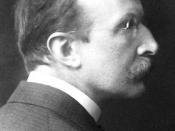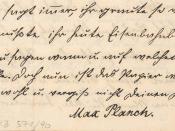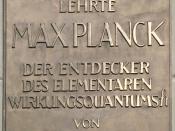Max Karl Ernst Ludwig Planck (1858 - 1947) was a German physicist who was of the first people to contribute to the invention of quantum theory. After studying physics at Munchen University, he moved to Berlin where, in 1889, Planck discovered a new fundamental constant (h), which is named Planck's constant. It is, among other things, used to calculate the energy of a photon, which are energy atoms. His discoveries showed that in addition to the atomistic structure of matter, energy also possesses an atomistic structure, which is governed by the universal constant h.
A year later, Planck discovered the Law of Heat Radiation, also known as Planck's Law of Radiation. This law uses Planck's constant, (h), the Boltzman constant, (k), and the speed of light to show the intensity of radiation emitted by a unit's surface area into a fixed direction. This law became the basis of quantum theory, and Planck was awarded the Nobel Peace Prize in 1918 for his work.
From 1905 to 1909 Planck was the head of the German Physical Society. Then, in 1913, Planck became head of Berlin University.
Planck's work opened up the floodgates to the studies of quantum theory and led to many additional discoveries by various scientists. Without his discovery of Planck's constant, it would a workable theory the energy processes that govern the transformations of atoms and molecules would not have emerged. His theories dramatically altered former physical mechanics and electrodynamics and significantly contributed to the quest for scientific knowledge of energy.
Works Cited:
"Max Planck - Wikipedia." Max Planck. 12 Feb. 2006. Wikipedia, the Free
Encyclopedia. 12 Feb. 2006 .
McNeil PhD., Russell. Malaspinia Great Books - Max Planck (1858). Malaspina Great
Books. 12 Feb. 2006
.
"Quantum mechanics - Wikipedia." Quantum Mechanics. 12 Feb. 2006. Wikipedia, the...


